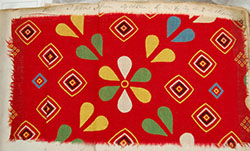An unexpected approach to calico printing

This project focuses on the books of Turkey Red Co. pattern samples held by the University Archives. The printing process and the chemistry behind it will feature in a display and a workshop.
Follow the project's progress via a series of videos here: http://glasgowdyesproject.tumblr.com/HAP2013
Imagine you want to create this calico print:
What do you need? White cloth, each colour of dye, and the printing patterns? Not exactly.
If you want fabric with the vivid shade of red pictured here, you’ll need Turkey red calico. But here’s the catch: Turkey red is a dye produced within the cloth itself, using a multi-day dyeing process which turns a white cotton into a bright, bleach-resistant red. There's no way to make only part of the cloth red, but there are ways to add different colours afterward. So, brilliant Turkey red cloth in hand, you can design your pattern and begin to add other colours.
Method
To print a pattern, the design for each colour is carved onto printing blocks or rollers in reverse, just like a woodcut or ink stamp. Earlier processes used hand-carved blocks, but the piece in the image above was printed with an embossed cylinder. This allowed the printing process to be continuous and mechanized. The design on the printing cylinder allows the precise application of the materials needed to create the multi-coloured pattern.
Adding Colour
Turkey red printers could make prints with up to five additional colours: white, blue, black, yellow, and green. Here’s how to do it:
White: You make a paste of acidified clay and apply to the cloth using the pattern roller. Liquid bleach reacts with this paste, removing the colour only in where the pattern is.
Blue: This time you make a similar paste with a blue powdered dye that is also bleach-resistant. As the red fades, the blue is applied.
Black: You use the same paste as for blue, but with no acid. This leaves the cloth red but put the blue on top of it. The two strong colours together made a solid black.
Yellow: The same paste for bleaching is used, this time mixed with a compound called lead nitrate. After you bleach the fabric, you dip it in another solution of potassium bichromate. Both lead and chromium are highly toxic substances for you to work with. The lead and chromium react to form a yellow compound, lead chromate, that stays within the fibre even after washing.
Green: This colour is made by applying the chemicals to make yellow over areas that have been printed blue.
Julie Wertz, Phd Candidate, History of Art
PhD Research
Textile dyeing in late nineteenth-century Glasgow: Interpreting and re-creating the dye chemists’ experiments from lab to manufacture
For updates on research and talks: http://glasgowdyesproject.tumblr.com/
Twitter: @glasgow_dyes

